Winter is the easiest season of the year for lawn maintenance in most of the golf courses in the north that have been closed. The focus of work during this period is to formulate a lawn maintenance plan for the coming year, participate in various trainings or related seminars, and train lawn department employees. Although winter lawn maintenance operations are no longer the focus of work, maintenance details such as watering and cold protection still need to be particularly careful. A slight negligence may cause the lawn to fail to turn green early in spring, or even die in a large area. Among these many problems, winter lawn watering and preventing frost from being trampled on are the two most noteworthy details.
First of all, winter lawn watering is one of the details that cannot be ignored. One of the important reasons for the death of winter lawns is dehydration. On the surface, this is caused by a sudden drop in temperature and cold damage. Studies have shown that a sudden drop in temperature, especially a sudden thaw, can indeed cause the death of lawns, but the semi-lethal temperatures of cold-season lawn grasses and warm-season lawn grasses are both below -15℃ or -5℃, respectively, and temperature is not the main cause of their death. In fact, dehydration is the culprit of winter lawn death. For example, in the cold winter, some cold-resistant lawn grass species such as creeping bentgrass often die not because of low temperature, but because of drought and dehydration. In winter, the lawn of the stadium can be watered manually by using pipes. The watering time is generally arranged at noon on a sunny day when there is no snow on the lawn, and the lawn of the stadium is replenished with water in small amounts and multiple times. In northern regions, the harsh winter wind can pass through the lawn without snow, causing severe dehydration of the lawn. Therefore, the lawn in the windward part of the stadium should be watered more frequently.
In order to prevent the lawn from dehydrating, the operation of replenishing water to the lawn must be careful, and water should not be accumulated on the surface of the lawn, otherwise it will be too much, causing the low-lying lawn to freeze and suffocate to death. Frozen suffocation refers to the phenomenon that when the cold comes, the ice layer on the surface of the lawn hinders the gas exchange between the lawn soil and the atmosphere, resulting in the suffocation of the lawn grass due to lack of oxygen and accumulation of harmful gases in the soil below the ice layer.
For cool-season turfgrasses, freezing suffocation is not the main cause of turfgrass damage. Most frost damage is caused by the immersion of turfgrass rhizomes in water before freezing, which causes excessive accumulation of harmful substances. Therefore, through reasonable drainage, most cool-season turfgrasses can withstand more than 60 days of freezing or ice cover.

Avoiding trampling of frost turf is another detail that needs special attention in winter golf course turf maintenance. When the temperature of turfgrass blades is lower than the ambient air temperature, water vapor in the air condenses on the surface of the blades. This phenomenon is called condensation. Condensation is the opposite process of evaporation. When the temperature is high, dew forms on the turf blades. When the temperature drops below freezing at night, the dew turns into frost. When frost forms, water vapor freezes between the turfgrass blades and cells. At this time, if the turf is trampled or rolled before the frost melts, it will cause serious damage to the turf. Due to the large area of the turf of the golf course, people walking, golf carts and turf maintenance machinery should try to avoid trampling on the frost turf, otherwise it will cause serious damage to the turf, or the color of the turf will turn purple when it turns green again. In severe cases, it will affect the greening process and even cause large-scale lawn death.
Post time: Oct-15-2024
